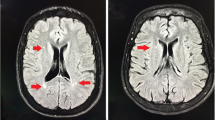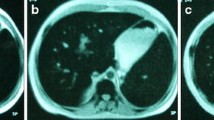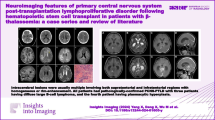Abstract
Covert brain infarction is an emerging concern in patients with β-thalassemia intermedia (TI). We have recently observed a high prevalence (60%) of silent brain infarction on brain magnetic resonance imaging (MRI) in 30 splenectomized adults with TI. In this work, we further evaluate cerebral involvement in the same 30 patients using fluorodeoxyglucose positron emission tomography–computed tomography (PET-CT) scanning. The median age was 32 years (range, 18–54 years) with a male to female ratio of 13:17. Nineteen patients (63.3%) had evidence of decreased neuronal function on PET-CT. Involvement was mostly left sided, multiple, and most commonly in the temporal and parietal lobes. Elevated liver iron concentration, beyond 15 mg Fe/g dry weight, characterized patients with decreased neuronal function. The concordance rate between brain MRI and PET-CT for the detection of brain abnormality was only 36.7% (Kappa 0.056, P = 0.757), highlighting that both modalities reveal different types of brain pathology. Decreased neuronal function is a common finding in patients with TI and is associated with iron overload. Moreover, the addition of PET-CT to MRI identifies a greater proportion of TI patients with silent neuroimaging abnormalities.


Similar content being viewed by others

References
Taher AT, Musallam KM, Cappellini MD, Weatherall DJ (2011) Optimal management of β thalassaemia intermedia. Br J Haematol 152:512–523
Steinberg MH, Forget BG, Higgs DR, Weatherall DJ (2009) Disorders of hemoglobin: genetics pathophysiology, and clinical management, 2nd edn. Cambridge University Press, Cambridge
Cappellini MD, Motta I, Musallam KM, Taher AT (2010) Redefining thalassemia as a hypercoagulable state. Ann N Y Acad Sci 1202:231–236
Taher AT, Musallam KM, El-Beshlawy A, Karimi M, Daar S, Belhoul K, Saned MS, Graziadei G, Cappellini MD (2010) Age-related complications in treatment-naive patients with thalassaemia intermedia. Br J Haematol 150:486–489
Taher AT, Musallam KM, Karimi M, El-Beshlawy A, Belhoul K, Daar S, Saned MS, El-Chafic AH, Fasulo MR, Cappellini MD (2010) Overview on practices in thalassemia intermedia management aiming for lowering complication rates across a region of endemicity: the OPTIMAL CARE study. Blood 115:1886–1892
Taher A, Isma'eel H, Mehio G, Bignamini D, Kattamis A, Rachmilewitz EA, Cappellini MD (2006) Prevalence of thromboembolic events among 8,860 patients with thalassaemia major and intermedia in the Mediterranean area and Iran. Thromb Haemost 96:488–491
Cappellini MD, Robbiolo L, Bottasso BM, Coppola R, Fiorelli G, Mannucci AP (2000) Venous thromboembolism and hypercoagulability in splenectomized patients with thalassaemia intermedia. Br J Haematol 111:467–473
Taher AT, Musallam KM, Karimi M, El-Beshlawy A, Belhoul K, Daar S, Saned M, Cesaretti C, Cappellini MD (2010) Splenectomy and thrombosis: the case of thalassemia intermedia. J Thromb Haemost 8:2152–2158
Atichartakarn V, Angchaisuksiri P, Aryurachai K, Onpun S, Chuncharunee S, Thakkinstian A, Atamasirikul K (2002) Relationship between hypercoagulable state and erythrocyte phosphatidylserine exposure in splenectomized haemoglobin E/beta-thalassaemic patients. Br J Haematol 118:893–898
Rund D, Rachmilewitz E (2005) Beta-thalassemia. N Engl J Med 353:1135–1146
Manfre L, Giarratano E, Maggio A, Banco A, Vaccaro G, Lagalla R (1999) MR imaging of the brain: findings in asymptomatic patients with thalassemia intermedia and sickle cell-thalassemia disease. AJR Am J Roentgenol 173:1477–1480
Taher AT, Musallam KM, Nasreddine W, Hourani R, Inati A, Beydoun A (2010) Asymptomatic brain magnetic resonance imaging abnormalities in splenectomized adults with thalassemia intermedia. J Thromb Haemost 8:54–59
Camaschella C, Cappellini MD (1995) Thalassemia intermedia. Haematologica 80:58–68
St Pierre TG, Clark PR, Chua-anusorn W, Fleming AJ, Jeffrey GP, Olynyk JK, Pootrakul P, Robins E, Lindeman R (2005) Noninvasive measurement and imaging of liver iron concentrations using proton magnetic resonance. Blood 105:855–861
Afifi AA, Clark V, May S (2004) Computer-aided multivariate analysis, 4th edn. Chapman & Hall/CRC, New York, p 489
Taher A, Hershko C, Cappellini MD (2009) Iron overload in thalassaemia intermedia: reassessment of iron chelation strategies. Br J Haematol 147:634–640
Taher A, El Rassi F, Isma'eel H, Koussa S, Inati A, Cappellini MD (2008) Correlation of liver iron concentration determined by R2 magnetic resonance imaging with serum ferritin in patients with thalassemia intermedia. Haematologica 93:1584–1586
Roghi A, Cappellini MD, Wood JC, Musallam KM, Patrizia P, Fasulo MR, Cesaretti C, Taher AT (2010) Absence of cardiac siderosis despite hepatic iron overload in Italian patients with thalassemia intermedia: an MRI T2* study. Ann Hematol 89:585–589
Taher AT, Musallam KM, Wood JC, Cappellini MD (2010) Magnetic resonance evaluation of hepatic and myocardial iron deposition in transfusion-independent thalassemia intermedia compared to regularly transfused thalassemia major patients. Am J Hematol 85:288–290
Origa R, Barella S, Argiolas GM, Bina P, Agus A, Galanello R (2008) No evidence of cardiac iron in 20 never- or minimally-transfused patients with thalassemia intermedia. Haematologica 93:1095–1096
Li X, Jankovic J, Le W (2011) Iron chelation and neuroprotection in neurodegenerative diseases. J Neural Transm 118:473–477
Verduzco LA, Nathan DG (2009) Sickle cell disease and stroke. Blood 114:5117–5125
Rodgers GP, Clark CM, Larson SM, Rapoport SI, Nienhuis AW, Schechter AN (1988) Brain glucose metabolism in neurologically normal patients with sickle cell disease. Regional alterations. Arch Neurol 45:78–82
Powars DR, Conti PS, Wong WY, Groncy P, Hyman C, Smith E, Ewing N, Keenan RN, Zee CS, Harold Y, Hiti AL, Teng EL, Chan LS (1999) Cerebral vasculopathy in sickle cell anemia: diagnostic contribution of positron emission tomography. Blood 93:71–79
Herold S, Brozovic M, Gibbs J, Lammertsma AA, Leenders KL, Carr D, Fleming JS, Jones T (1986) Measurement of regional cerebral blood flow, blood volume and oxygen metabolism in patients with sickle cell disease using positron emission tomography. Stroke 17:692–698
Labbe C, Froment JC, Kennedy A, Ashburner J, Cinotti L (1996) Positron emission tomography metabolic data corrected for cortical atrophy using magnetic resonance imaging. Alzheimer Dis Assoc Disord 10:141–170
Mehta RC, Marks MP (1992) Physiologic imaging of the brain. Curr Opin Radiol 4:95–100
Reed W, Jagust W, Al-Mateen M, Vichinsky E (1999) Role of positron emission tomography in determining the extent of CNS ischemia in patients with sickle cell disease. Am J Hematol 60:268–272
Gross H, Kling A, Henry G, Herndon C, Lavretsky H (1996) Local cerebral glucose metabolism in patients with long-term behavioral and cognitive deficits following mild traumatic brain injury. J Neuropsychiatry Clin Neurosci 8:324–334
Pegelow CH, Macklin EA, Moser FG, Wang WC, Bello JA, Miller ST, Vichinsky EP, DeBaun MR, Guarini L, Zimmerman RA, Younkin DP, Gallagher DM, Kinney TR (2002) Longitudinal changes in brain magnetic resonance imaging findings in children with sickle cell disease. Blood 99:3014–3018
Pegelow CH, Wang W, Granger S, Hsu LL, Vichinsky E, Moser FG, Bello J, Zimmerman RA, Adams RJ, Brambilla D (2001) Silent infarcts in children with sickle cell anemia and abnormal cerebral artery velocity. Arch Neurol 58:2017–2021
Switzer JA, Hess DC, Nichols FT, Adams RJ (2006) Pathophysiology and treatment of stroke in sickle-cell disease: present and future. Lancet Neurol 5:501–512
Hoffman JM, Welsh-Bohmer KA, Hanson M, Crain B, Hulette C, Earl N, Coleman RE (2000) FDG PET imaging in patients with pathologically verified dementia. J Nucl Med 41:1920–1928
Smith MA, Harris PL, Sayre LM, Perry G (1997) Iron accumulation in Alzheimer disease is a source of redox-generated free radicals. Proc Natl Acad Sci USA 94:9866–9868
Good PF, Perl DP, Bierer LM, Schmeidler J (1992) Selective accumulation of aluminum and iron in the neurofibrillary tangles of Alzheimer's disease: a laser microprobe (LAMMA) study. Ann Neurol 31:286–292
Miller ST, Macklin EA, Pegelow CH, Kinney TR, Sleeper LA, Bello JA, DeWitt LD, Gallagher DM, Guarini L, Moser FG, Ohene-Frempong K, Sanchez N, Vichinsky EP, Wang WC, Wethers DL, Younkin DP, Zimmerman RA, DeBaun MR (2001) Silent infarction as a risk factor for overt stroke in children with sickle cell anemia: a report from the Cooperative Study of Sickle Cell Disease. J Pediatr 139:385–390
Wang W, Enos L, Gallagher D, Thompson R, Guarini L, Vichinsky E, Wright E, Zimmerman R, Armstrong FD (2001) Neuropsychologic performance in school-aged children with sickle cell disease: a report from the Cooperative Study of Sickle Cell Disease. J Pediatr 139:391–397
Armstrong FD, Thompson RJ Jr, Wang W, Zimmerman R, Pegelow CH, Miller S, Moser F, Bello J, Hurtig A, Vass K (1996) Cognitive functioning and brain magnetic resonance imaging in children with sickle cell disease. Neuropsychology Committee of the Cooperative Study of Sickle Cell Disease. Pediatrics 97:864–870
Bernaudin F, Verlhac S, Freard F, Roudot-Thoraval F, Benkerrou M, Thuret I, Mardini R, Vannier JP, Ploix E, Romero M, Casse-Perrot C, Helly M, Gillard E, Sebag G, Kchouk H, Pracros JP, Finck B, Dacher JN, Ickowicz V, Raybaud C, Poncet M, Lesprit E, Reinert PH, Brugieres P (2000) Multicenter prospective study of children with sickle cell disease: radiographic and psychometric correlation. J Child Neurol 15:333–343
Kugler S, Anderson B, Cross D, Sharif Z, Sano M, Haggerty R, Prohovnik I, Hurlet-Jensen A, Hilal S, Mohr JP et al (1993) Abnormal cranial magnetic resonance imaging scans in sickle-cell disease. Neurological correlates and clinical implications. Arch Neurol 50:629–635
Vichinsky EP, Neumayr LD, Gold JI, Weiner MW, Rule RR, Truran D, Kasten J, Eggleston B, Kesler K, McMahon L, Orringer EP, Harrington T, Kalinyak K, De Castro LM, Kutlar A, Rutherford CJ, Johnson C, Bessman JD, Jordan LB, Armstrong FD (2010) Neuropsychological dysfunction and neuroimaging abnormalities in neurologically intact adults with sickle cell anemia. JAMA 303:1823–1831
De Reuck J, Leys D, De Keyser J (1997) Is positron emission tomography useful in stroke? Acta Neurol Belg 97:168–171
Arkuszewski M, Melhem ER, Krejza J (2010) Neuroimaging in assessment of risk of stroke in children with sickle cell disease. Adv Med Sci 55:115–129
Funding source
This study was supported by an unrestricted grant from Novartis Pharmaceuticals.
Conflicts of interest
ATT is a member of Novartis Speakers' Bureau.
Author information
Authors and Affiliations
Corresponding author
Additional information
Khaled M. Musallam and Wassim Nasreddine contributed equally as first authors.
Rights and permissions
About this article
Cite this article
Musallam, K.M., Nasreddine, W., Beydoun, A. et al. Brain positron emission tomography in splenectomized adults with β-thalassemia intermedia: uncovering yet another covert abnormality. Ann Hematol 91, 235–241 (2012). https://doi.org/10.1007/s00277-011-1291-3
Received:
Accepted:
Published:
Issue Date:
DOI: https://doi.org/10.1007/s00277-011-1291-3



